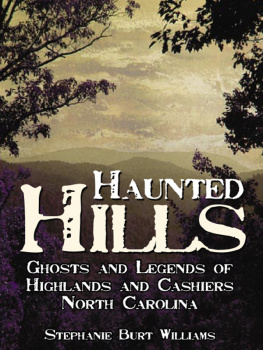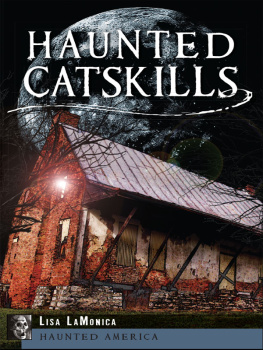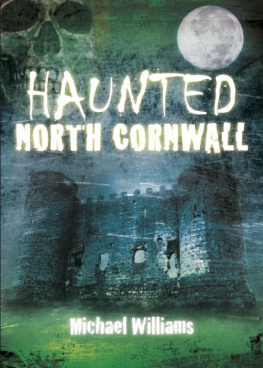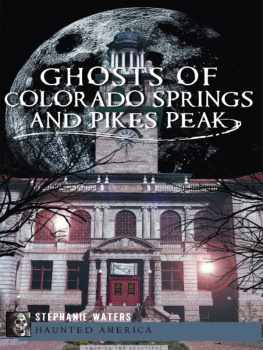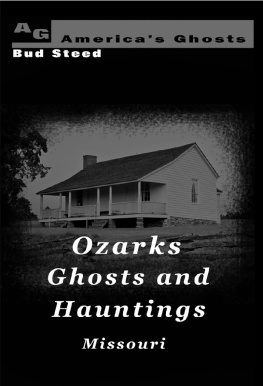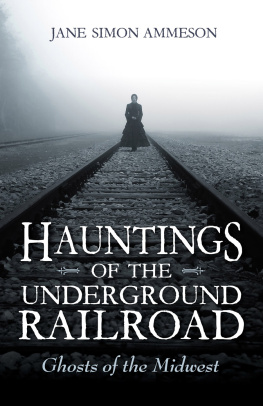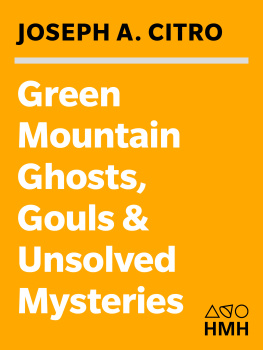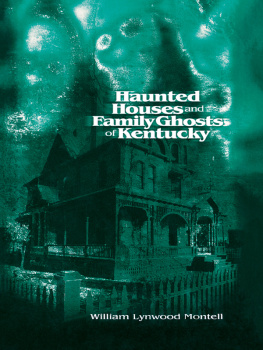

Published by Haunted America
A Division of The History Press
Charleston, SC 29403
www.historypress.net
Copyright 2007 by Stephanie Burt Williams
All rights reserved
Front cover: photo by the author.
First published 2007
Second printing 2008
e-book edition 2013
Manufactured in the United States
ISBN 978.1.62584.410.1
Library of Congress Cataloging-in-Publication Data
Williams, Stephanie Burt.
Haunted hills : ghosts and legends of Highlands and Cashiers, North Carolina / Stephanie Burt Williams.
p. cm.
print edition ISBN 978-1-59629-257-4 (alk. paper)
1. Ghosts--North Carolina. 2. Haunted places--North Carolina. 3. Legends--North Carolina. I. Title.
BF1472.U6W555 2007
133.10975695--dc22
2007026828
Notice: The information in this book is true and complete to the best of our knowledge. It is offered without guarantee on the part of the author or The History Press. The author and The History Press disclaim all liability in connection with the use of this book.
All rights reserved. No part of this book may be reproduced or transmitted in any form whatsoever without prior written permission from the publisher except in the case of brief quotations embodied in critical articles and reviews.
For Bob, my hiking partner to the bottom of Rainbow Falls and back out again
CONTENTS
ACKNOWLEDGEMENTS
Thanks first to Melody Spurney, managing editor of The Highlander, whose encouragement and enthusiasm for my series of ghost stories (while a staff writer) got this whole thing rolling. Thanks also to Ran Shaffner, not only for his quintessential history of Highlands, but also for his immense dedication to archiving Highlandss visual history through the photography collection of the Highlands Historical Society. Rhonda Gray Alexander at the Cashiers General Store was my Cashiers connection and provided me with a wealth of information and many contacts. And thanks most of all to my family and friends for their encouragement and patience throughout this project.
INTRODUCTION
It is easy to understand how the North Carolina mountains hold secrets. There may be a waterfall around a bend, hidden deep in a pocket of rhododendron on the curve of a rocky path. Deep foliage can reveal a mossy garden in a glade with a single glance, and a bear and her family may inexplicably show up on your front lawn, frolicking under the birdfeeder. In short, it is a place that does not reveal itself all at once.
The towns of Highlands and Cashiers are deep in these mountains; they are not in the foothills where the hills are rolling and the roads are often wide. The roads here often have serious switchbacks that require drivers to slow down and notice the precarious nature of their journeys. In fact, there are no superhighways with Highlands or Cashiers as an exit (complete with a fast-food joint and a mega gas station). No, Highlands and Cashiers are about the quieter life, about vacations and escape from the everyday hustle and bustle of the cities. The towns are full of the sounds of rushing water, of cool night breezes with the windows open and of a golf ball hitting a green.

The Highlands-Cashiers area is rich in folkloreand breathtaking views such as this one. Photo by the author.
Deep in these places are whispered the stories that need to be passed down. They are tales of magic, of the unexplained and of violence that traps souls still trying to make contact today. These are those stories.
HIGHLANDS
There is a legend about the founding of Highlands. It is said that two developers took a map and drew a line from New York City to New Orleans, then drew another line between Chicago and Savannah. They saw these routes as the great trade routes of the future, and of course where they crossed on the map would be a great population center, full of commerce and bustling activity. So they set out to settle that crossroads where the two lines met. It was Highlands, sitting high on a mountain plateau, with an elevation of 4,118 feet.
Obviously, Highlands never became the commercial center for which the pioneers had hoped. Anchored by a few blocks of Main Street, Highlands spreads out in residential communities and country clubs east toward Cashiers, west toward Franklin and south toward Rabun County, Georgia. But it has always remained mostly a seasonal town, with summers bringing well-heeled tourists from Atlanta and the winter left to the roughly nine hundred residents who call it home year-round.

Looking west on Main Street in Highlands. Photo courtesy of the Highlander.
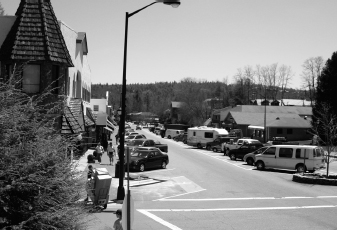
Looking east on Main Street in Highlands. Photo courtesy of the Highlander.

Highlands Sanatorium, or Bug Hill, was a social and medical center in Highlands. All the little buildings situated in rows on the hill are the open-air tents for tuberculosis patients. Photo circa 1910, courtesy of the Highlands Historical Society.
Despite its small size, it has always been a destination in the southwest North Carolina mountains. Dr. Mary Lapham, noted for her Swiss therapy for tuberculosis, opened Highlands Sanatorium, which soon became a social center and employer for many people in the town. Bug Hill, as it became commonly known, brought people from Atlanta, Asheville, Savannah and Charleston for a cure through crisp mountain air and a variety of tuberculosis treatments.
It next became a destination for golf when a new golf course in Highlands became a practice course for legendary golfer Bobby Jones. Construction of courses expanded as the games popularity increased, and today golfing is a large part of Highlands culture.
Highlandss modern era has seen a juxtaposition of the old and new. High-boutique shops and a lavish spa share the same street with a pharmacy that still has a lunch counter and an old inn that does not have central heating. Old buildings sit next to new ones, and hikers, shoppers and mountain folk mix on the same street.
KALALANTA
The Sea Captain Likes the View
Its a myth that all sea captains long for the sea. Some long for the mountains.
Kalalanta, named after the Cherokee word for high place or heaven, is a stately home on Bowery Road, a road that, although only a few blocks from the town center, is unpaved and quite winding. And its residents like it that way, fighting to keep their road unpaved. As one of the oldest residential streets in Highlands, its unpaved quality is part of what residents consider its historic character.
Kalalanta is a tall clapboard home that is situated on a lush lawn among rhododendron and hemlock. It stands tall over an impressive view of Horse Cove below and the South Carolina mountains beyond. It is one of many homes on Bowery Road filled with vacationers during the high tourist season.
Next page
